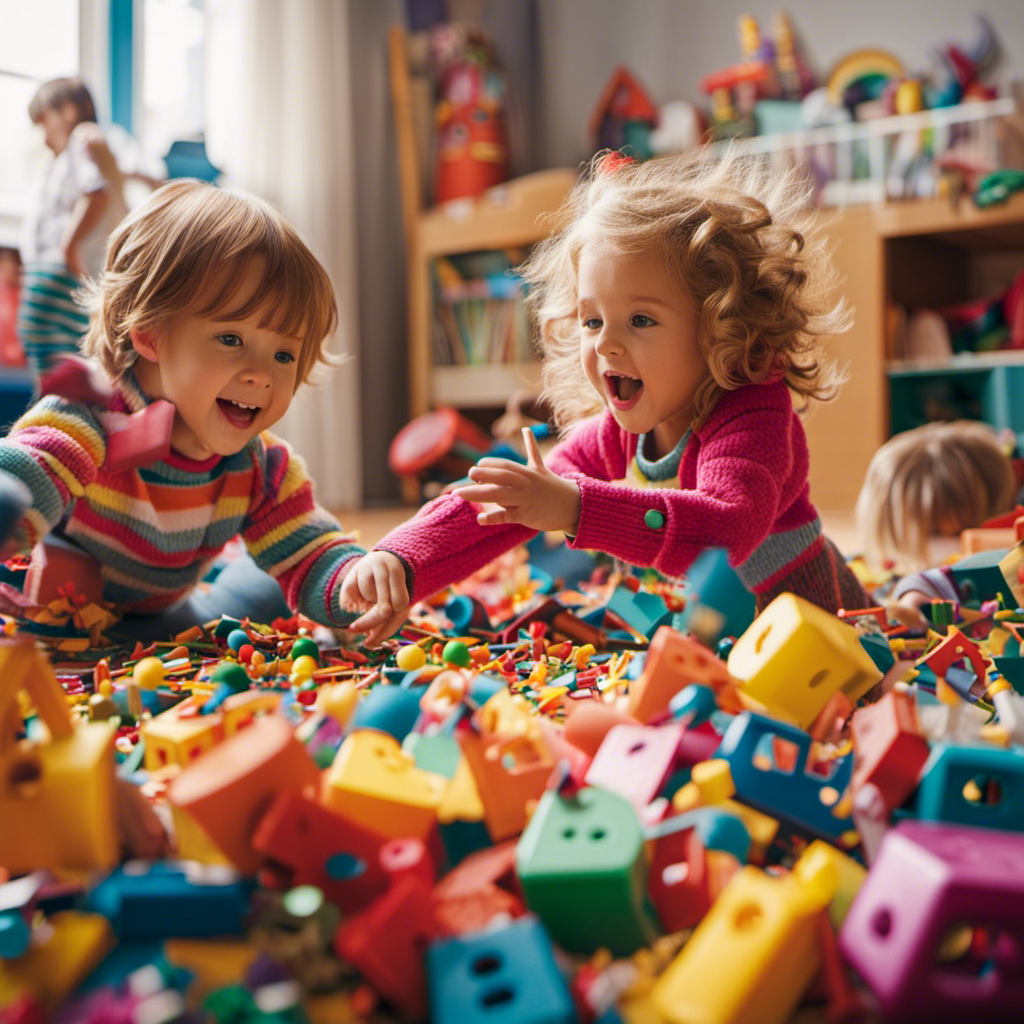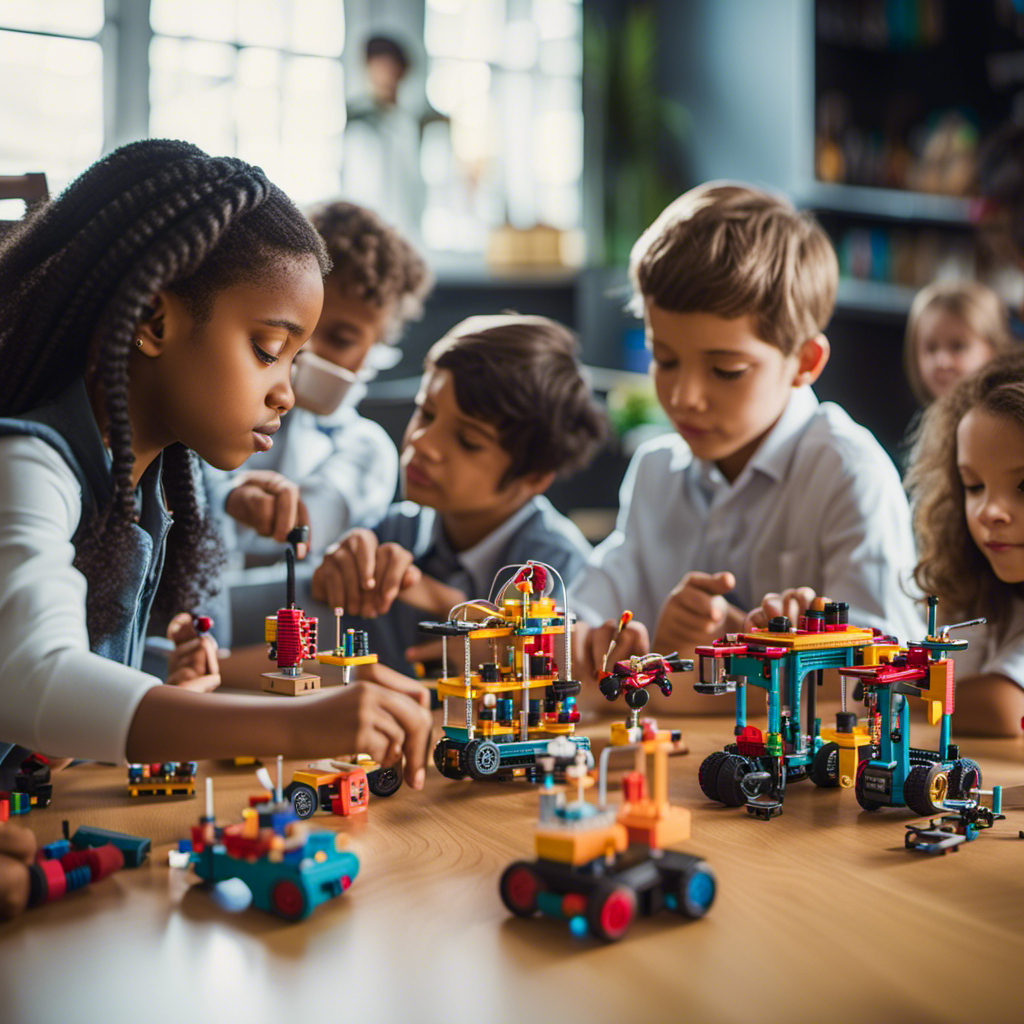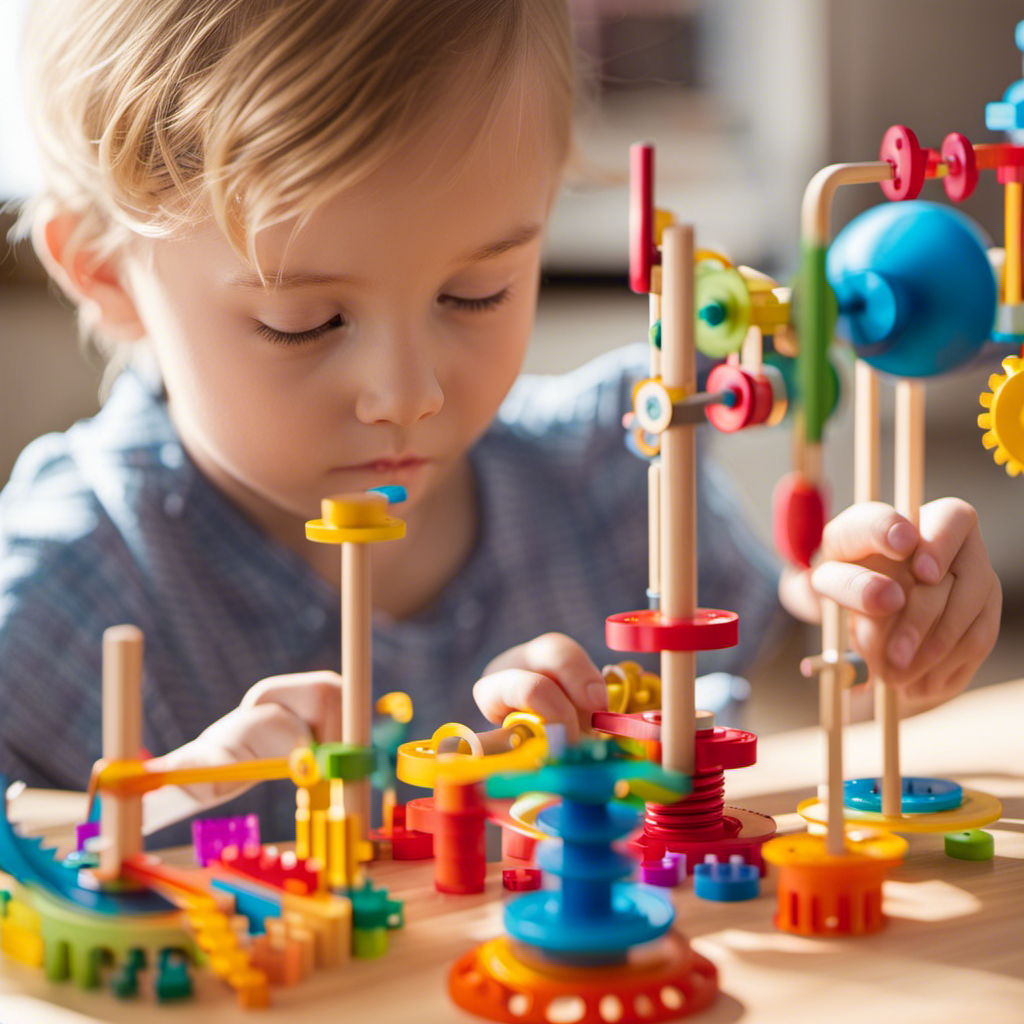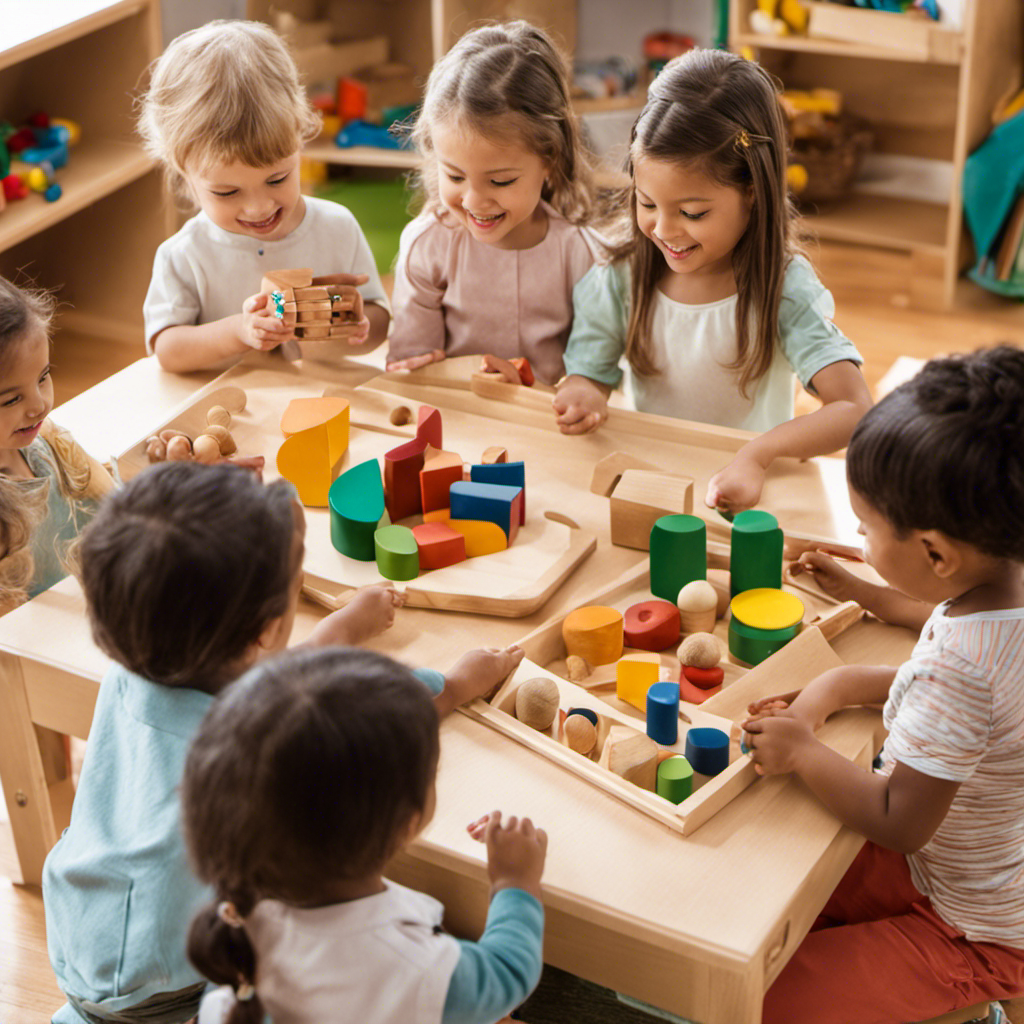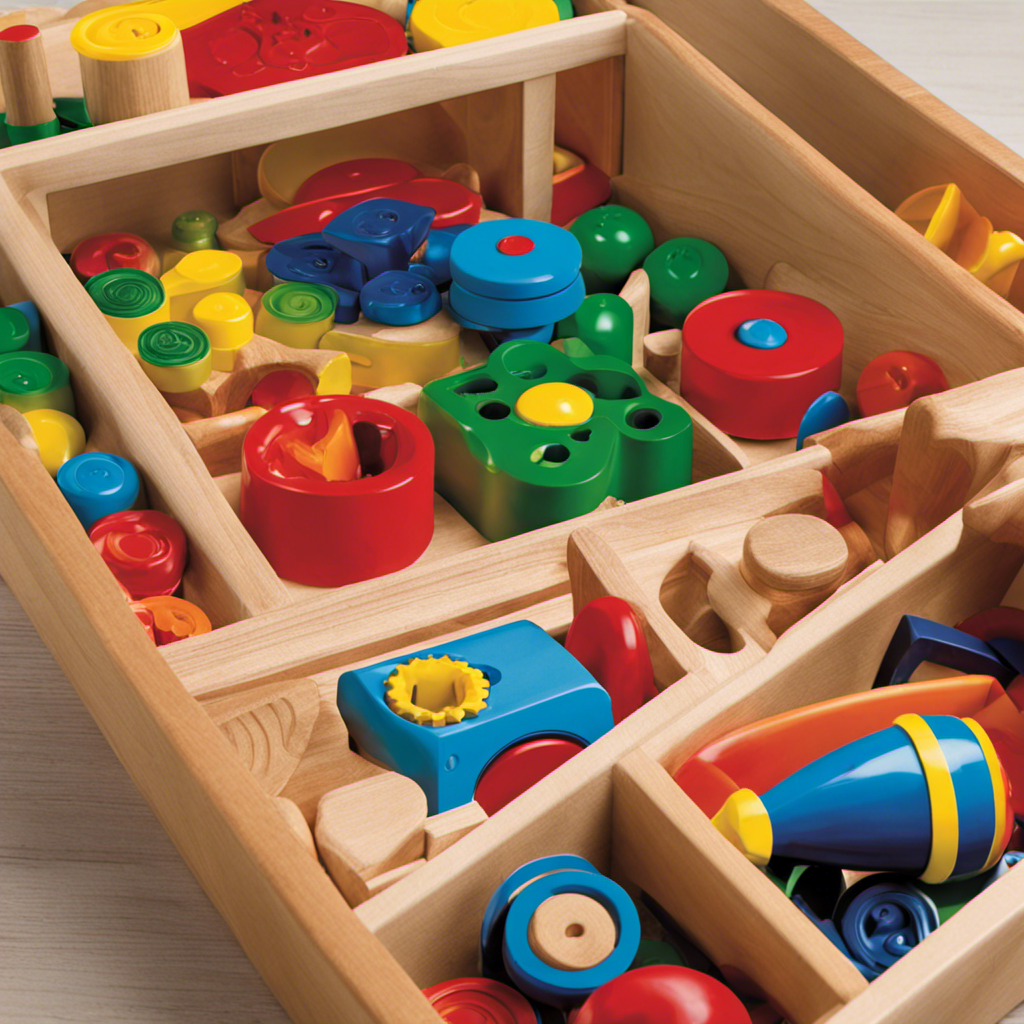In my study of child development, I have discovered that there is a deeper meaning behind children damaging toys in preschool and daycare environments than meets the eye. It is not just about the broken toys, but rather about the reasons behind this behavior.
In this article, we will delve into the factors influencing toy breakage, from age and peer influence to environmental factors. By understanding these dynamics, we can implement strategies to prevent breakage incidents and create a safer, more enriching environment for our little ones.
Key Takeaways
- Use of age-inappropriate toys and lack of effective behavior management strategies contribute to toy breakage in preschool and daycare settings.
- Motor skills, including fine motor skills and gross motor skills, play a significant role in handling toys and unintentional mishandling may lead to breakage.
- Sensory integration difficulties and lack of control and understanding of force are factors that contribute to toy breakage incidents.
- The physical environment, peer influence, and emotional regulation abilities also play a role in toy breakage incidents in childcare settings.
Reasons for Toy Breakage in Preschool and Daycare Settings
If you’re wondering why children in preschool and daycare break toys, there are a few common reasons. One of the primary reasons is the use of toys that may not be age appropriate for the children. In these early childhood settings, it is crucial to ensure that the toys provided are suitable for the developmental stage of the children.
When children are given toys that are too advanced for their age, they may become frustrated and exhibit rough behavior, leading to toy breakage. This is why it is essential for caregivers and educators to carefully select toys that are designed for the specific age group they are working with.
Another factor that contributes to toy breakage is the lack of effective behavior management strategies. In preschool and daycare settings, children are still learning how to regulate their emotions and impulses. When these skills are not adequately developed, children may resort to destructive behaviors, such as breaking toys, to release their frustration or gain attention.
Implementing appropriate behavior management techniques, such as setting clear expectations and providing positive reinforcement, can help minimize toy breakage incidents.
Understanding the impact of age and developmental stage on toy breakage is crucial in addressing this issue effectively. By acknowledging the specific needs and abilities of each age group, caregivers and educators can select appropriate toys and implement behavior management strategies that promote positive play experiences.
Impact of Age and Developmental Stage on Toy Breakage
As an expert in child development, I will now discuss the impact of age and developmental stage on toy breakage.
Age and motor skills play a significant role in a child’s ability to handle toys and manipulate them without causing damage.
Additionally, cognitive development factors, such as problem-solving abilities and attention span, can also influence how children interact with toys and their likelihood of breaking them.
Age and Motor Skills
Children in preschool and daycare often struggle with age-appropriate motor skills, which can contribute to them breaking toys. Motor development plays a crucial role in a child’s ability to manipulate objects and engage in play activities. Here are four key points to consider regarding motor development and toy breakage:
-
Fine motor skills: Preschoolers are still refining their hand-eye coordination and finger dexterity, making it challenging for them to handle toys delicately.
-
Gross motor skills: Children with underdeveloped gross motor skills may unintentionally knock over or drop toys, increasing the risk of breakage.
-
Sensory integration: Difficulties in sensory processing can affect a child’s ability to regulate their movements, leading to unintentional mishandling of toys.
-
Lack of control: Young children may lack the necessary control and understanding of force, causing them to exert excessive pressure or mishandle toys, resulting in breakage.
Understanding these motor development factors can help educators and caregivers create an environment that supports children’s motor skills and minimizes toy breakage.
As we delve into cognitive development factors, we can further explore how these aspects influence children’s toy interactions.
Cognitive Development Factors
Understanding how cognitive development factors influence a child’s interaction with toys can provide valuable insights for educators and caregivers.
Language development plays a crucial role in a child’s ability to engage with toys effectively. As children develop their language skills, they can communicate their needs, preferences, and ideas more clearly, enhancing their play experiences.
Moreover, problem-solving skills also contribute to how children interact with toys. As their cognitive abilities develop, children become more adept at solving problems, which allows them to engage in more complex and challenging play activities.
By understanding these cognitive development factors, educators and caregivers can select appropriate toys that promote language development and problem-solving skills, fostering optimal learning and growth in children.
Transitioning into the subsequent section about emotional regulation abilities, it is important to consider how these factors also impact a child’s ability to regulate their emotions during play.
Emotional Regulation Abilities
When it comes to emotional regulation abilities, you can support a child’s ability to manage their emotions during play by providing a safe and nurturing environment. Emotional regulation challenges can arise when children struggle to control their emotions, leading to behaviors that may include toy breakage.
As a caregiver or teacher, it is important to understand effective behavior management techniques to help children develop their emotional regulation skills. This includes teaching them appropriate ways to express their emotions, such as using words instead of resorting to destructive behaviors. By setting clear expectations and providing consistent guidance, children can learn to regulate their emotions and engage in play without resorting to destructive actions.
Understanding the role of emotional regulation in behavior management is crucial for creating a positive and supportive environment for children to learn and grow.
Now let’s explore the environmental factors contributing to toy breakage in childcare settings.
Environmental Factors Contributing to Toy Breakage in Childcare Settings
One possible sentence could be: ‘The excessive use and rough handling of toys by young children can cause them to break easily in preschool and daycare settings.’
When it comes to understanding why children in preschool and daycare break toys, it is important to consider the role of environmental factors. The physical environment in these settings plays a significant role in shaping children’s behavior and their interactions with toys. Additionally, the development of motor skills can also contribute to toy breakage incidents. As children are still developing their fine motor skills, they may lack the coordination and control needed to handle toys gently. Moreover, the use of toys in activities that promote the development of motor skills, such as building blocks or puzzles, can increase the risk of accidental breakage.
These environmental factors, combined with the natural curiosity and exploration of young children, create a context where toy breakage incidents are more likely to occur.
Understanding the role of peer influence in toy breakage incidents is crucial in addressing this issue.
The Role of Peer Influence in Toy Breakage Incidents
In examining the role of peer influence in toy breakage incidents, it is important to consider the impact of social pressure on behavior. Children are often influenced by their peers and may engage in actions that they observe others doing.
This can include copying the actions of peers when it comes to handling toys, which can ultimately lead to an increase in toy breakage incidents. Understanding the influence of peer behavior on toy breakage is crucial in developing effective strategies for preventing and mitigating such incidents in childcare settings.
Social Pressure on Behavior
You might feel social pressure to behave a certain way when you’re around other children in preschool or daycare, which could lead to breaking toys. Peer pressure and social learning play significant roles in shaping a child’s behavior.
Here are four reasons why social pressure can influence children to break toys:
- Desire for acceptance: Children may break toys to gain attention or approval from their peers, as they believe destructive behavior makes them more popular.
- Mimicking others: Children often imitate the actions of their peers, especially if they see them breaking toys. This behavior is driven by the need to fit in and belong.
- Need for power: Breaking toys can be an attempt to assert dominance or control over others. Children may feel empowered when they see the reactions of their peers.
- Lack of impulse control: Some children struggle with impulse control and may break toys without fully considering the consequences, especially when influenced by their peers.
Understanding the social pressure and social learning dynamics at play can help us address and prevent toy breakage incidents.
In the next section, we will explore the impact of copying actions of peers on children’s behavior.
Copying Actions of Peers
When you’re around your friends, sometimes you might find yourself imitating the things they do. This is because of peer influence and behavior modeling, which play a significant role in shaping our actions.
Research suggests that children in preschool and daycare are particularly susceptible to copying the actions of their peers. They observe how their friends behave and often feel the need to imitate that behavior to fit in and be accepted.
This can be seen in various contexts, including how children interact with toys. For example, if one child starts throwing toys or breaking them, others may follow suit, thinking it’s the norm.
This peer influence on toy breakage can result in an increased likelihood of toys being damaged or broken in preschool and daycare settings, which can be problematic for both the children and educators.
Influence on Toy Breakage
If your peers start throwing or breaking toys, it’s common for others to imitate that behavior, leading to an increase in toy breakage. The influence of parenting styles and the role of temperament play significant roles in these incidents.
Research suggests that children who are exposed to permissive parenting, where rules and boundaries are not consistently enforced, are more likely to engage in disruptive behaviors such as toy breakage. Conversely, children raised in authoritative parenting environments, where expectations and consequences are clear, are less likely to engage in such behaviors.
Additionally, a child’s temperament can also contribute to their inclination to break toys. Children with more impulsive and aggressive temperaments may be more prone to engaging in destructive behaviors.
Understanding the influence of parenting styles and considering a child’s temperament can help inform strategies for preventing toy breakage in preschool and daycare settings.
Strategies for Preventing Toy Breakage in Preschool and Daycare Settings
To prevent toy breakage in preschool and daycare settings, it’s important to implement strategies that promote proper handling and care. By encouraging responsible play and providing clear guidelines, we can minimize the risk of toys getting damaged.
Here are some effective strategies for toy maintenance and promoting responsible play:
- Educate children about the importance of gentle handling and treating toys with care.
- Establish rules and expectations for toy usage, such as no throwing or rough play.
- Encourage children to clean up after themselves, teaching them to put toys back in their designated places when they are finished.
- Regularly inspect toys for any signs of wear and tear, and promptly repair or replace them to ensure continued safety and enjoyment.
The Importance of Age-Appropriate Toys in Reducing Breakage Incidents
In order to prevent toy breakage in preschool and daycare settings, it is crucial to promote age-appropriate play. By providing children with toys that are suitable for their developmental stage, we can greatly reduce the risk of breakage incidents.
Age-appropriate toys are designed to meet the physical, cognitive, and emotional needs of children at different stages of their development. For example, infants and toddlers require toys that are safe and easy to grasp, while preschoolers benefit from toys that encourage problem-solving and imaginative play.
One strategy for promoting age-appropriate play is to carefully select toys that align with the developmental milestones of the children in your care. This can be done by consulting reputable sources such as child development experts or toy safety organizations. Additionally, regularly assessing and rotating toys can ensure that children have access to a variety of age-appropriate options.
Supervision Techniques to Minimize Toy Breakage in Childcare Settings
One effective way to minimize toy breakage in childcare settings is through consistent and attentive supervision. As a childcare professional, I understand the importance of implementing effective supervision techniques to ensure the safety of the children and the longevity of the toys.
Here are four key supervision techniques that can help minimize toy breakage incidents:
-
Active Monitoring: By actively observing the children at play, you can quickly identify any potential behavior that may lead to toy breakage. This allows you to intervene promptly and redirect their attention to appropriate play.
-
Setting Clear Expectations: Establishing clear rules and expectations regarding toy handling and care can help children understand the importance of treating toys with respect. Encourage cooperative play and sharing to prevent any rough handling or misuse of toys.
-
Positive Reinforcement: Praise and reward children when they demonstrate appropriate toy handling and care. This positive reinforcement encourages them to continue these behaviors, reducing the likelihood of toy breakage.
-
Rotating Toys: Introduce a variety of toys and rotate them regularly. This not only keeps the children engaged and interested but also reduces the wear and tear on specific toys, decreasing the chances of breakage.
The Connection Between Behavior and Toy Breakage in Young Children
By understanding how behavior influences the durability of toys, you can effectively address and minimize instances of toy breakage in young kids. The impact of behavior on toy breakage is closely linked to child development. As children grow, they go through different stages and exhibit various behaviors that can contribute to the breakage of toys. Let’s take a look at the relationship between child development and toy breakage in the table below:
| Child Development Stage | Behavior | Impact on Toy Breakage |
|---|---|---|
| Toddler | Curiosity and exploration | Increased risk of accidental breakage |
| Preschooler | Rough play and experimentation | Higher likelihood of intentional breakage |
| School-age | Increased strength and coordination | Potential for more forceful breakage |
As children progress through these stages, their behavior evolves and so does the risk of toy breakage. Understanding and anticipating these behaviors can help caregivers and educators take proactive measures to prevent toy breakage incidents.
Transition: Now that we have explored the connection between behavior and toy breakage, let’s move on to how to handle toy breakage incidents in preschool and daycare environments.
How to Handle Toy Breakage Incidents in Preschool and Daycare Environments
When a toy gets broken, it’s important to address the situation calmly and provide guidance on how to handle the incident appropriately. Handling consequences and providing emotional support are crucial in preschool and daycare environments. Children at this age are still learning about cause and effect and may not fully understand the consequences of their actions. As educators and caregivers, it is our responsibility to teach them how to take responsibility for their actions and make amends when something goes wrong.
First and foremost, it’s essential to remain calm when a toy is broken. Reacting with anger or frustration can escalate the situation and make the child feel even worse. Instead, take a deep breath and approach the child with empathy. Let them know that accidents happen and reassure them that it’s okay. This will help them feel supported and less afraid to admit their mistakes in the future.
Next, it’s important to teach children about consequences. Help them understand that their actions have an impact on others and that they need to take responsibility for their choices. This can be done through simple conversations and discussions about cause and effect. For example, you can explain that when they throw a toy, it can break and hurt someone. By connecting their actions to the consequences, children can start to develop a sense of accountability.
Lastly, provide emotional support to the child involved. Breaking a toy can be upsetting for them, and they may feel guilt or shame. Offer comfort and reassurance, letting them know that it’s okay to make mistakes and that they can learn from this experience. Encourage them to apologize if necessary and help them brainstorm ways to fix or replace the broken toy, if possible.
Frequently Asked Questions
How Can Parents and Caregivers Address Toy Breakage Incidents in Preschool and Daycare Environments?
Effective discipline strategies and promoting positive behavior management are key when addressing toy breakage incidents in preschool and daycare environments.
As a parent or caregiver, it’s important to establish clear rules and expectations about how toys should be treated. Consistently reinforcing these guidelines and offering praise for appropriate behavior can help prevent toy breakage.
Additionally, redirecting children to alternative activities or providing them with appropriate outlets for their energy and creativity can minimize the likelihood of toys being broken.
Are There Specific Toy Materials That Are More Prone to Breakage in Childcare Settings?
When it comes to toy durability in childcare settings, certain materials are more prone to breakage. Plastic toys, especially those made with thin or brittle plastic, can easily crack or shatter.
Wooden toys, while sturdy, may splinter if not properly maintained. Additionally, toys with small parts or weak connections can pose potential hazards.
It’s important for caregivers to regularly inspect toys and choose ones made from durable materials to ensure the safety and longevity of playtime.
What Are Some Signs That a Child May Be More Likely to Engage in Toy Breakage Behavior?
Child temperament and parental guidance are important factors in understanding why some children may engage in toy breakage behavior. Children who are more impulsive or have difficulty regulating their emotions may be more likely to break toys. Similarly, children who have not been taught appropriate ways to handle toys or have not been given clear boundaries may also engage in toy breakage behavior.
How Can Peer Influence Be Managed to Minimize Toy Breakage Incidents in Preschool and Daycare Settings?
Managing peer influence is crucial in minimizing toy breakage incidents in preschool and daycare settings. It’s important to create a supportive and structured environment where children feel encouraged to engage in positive play.
By setting clear expectations and providing guidance, educators can help children understand the importance of respecting toys and the property of others.
Additionally, fostering communication and problem-solving skills among peers can empower children to resolve conflicts peacefully, reducing the likelihood of toy breakages.
Are There Any Legal or Safety Regulations in Place Regarding Toy Breakage Incidents in Childcare Facilities?
Legal and safety regulations play a crucial role in ensuring the well-being of children in preschool and daycare settings. These regulations are put in place to protect children from potential hazards, including toy breakage incidents.
They outline specific guidelines and requirements for the selection, maintenance, and use of toys in childcare facilities. By adhering to these regulations, providers can minimize the risk of toy breakage incidents and create a safe and nurturing environment for children to learn and play.
Conclusion
In conclusion, it is crucial to understand the reasons behind toy breakage in preschool and daycare settings. This understanding is essential for creating a safe and conducive environment for young children. By considering factors such as age, developmental stage, environmental influences, and peer influence, childcare providers can implement strategies to prevent toy breakage incidents.
One strategy is to utilize age-appropriate toys. Providing toys that are suitable for the children’s age and developmental stage can minimize the risk of breakage. Additionally, employing effective supervision techniques is important. Constantly monitoring the children while they play can help prevent rough handling or misuse of toys that may lead to breakage.
Addressing behavior issues promptly is another crucial aspect. If a child is displaying aggressive or destructive behavior towards toys, it is important to intervene and address the behavior immediately. By doing so, childcare providers can teach children appropriate ways to play with toys and prevent breakage incidents.
By handling toy breakage incidents with care and providing a nurturing environment, we can foster positive growth and development in our young learners. Creating an atmosphere where children feel supported and encouraged to explore and learn can help reduce the occurrence of toy breakage.
In summary, understanding the reasons behind toy breakage and implementing appropriate strategies can significantly reduce the occurrence of such incidents. By doing so, we can create a safe and conducive environment for young children, fostering their growth and development.
Tina is the heart and soul behind Toddler Ride On Toys. With a passion for early childhood education and a deep understanding of child development, Tina ensures that every piece of content on our website reflects our commitment to playful learning. Her expertise in Montessori, Preschool, STEM, and Waldorf education philosophies helps shape our website into a valuable resource for parents, caregivers, and educators.
